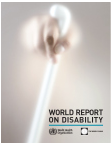Including children with disabilities: challenges and responses in School Health and Nutrition programmes
by Sergio Meresman, Rosangela Berman Bieler and Katia Edmundo
 The Global Report on Disability jointly produced by the World Health Organization (WHO) and the World Bank in 2011 focused attention on one of the larger yet less spoken about issues in development - people with disabilities.
The Global Report on Disability jointly produced by the World Health Organization (WHO) and the World Bank in 2011 focused attention on one of the larger yet less spoken about issues in development - people with disabilities.
With over one billion or 15% of the global population, people with a disability are one of the world's largest minority groups and yet they are also one of the most excluded and impoverished.
According to the report, even in developed countries disabled children are three times more like to be denied healthcare than other people. Children with disabilities are less likely to start or stay in school than other children. Most common and powerful barriers include stigma, discrimination, inaccessible transport, unprepared classrooms and teachers. In developing countries the picture is even worse. Despite a robust disability rights movement and a shift towards inclusion, disabled people remain second-class citizens.
Children who live with a physical, sensory, intellectual or mental health disability are amongst the most stigmatized and excluded of all the world’s children. Misunderstanding and fear of children with disabilities result in their marginalization within the family, community, at school, and in the wider society. The discrimination they suffer leads to poor health and education outcomes; affects the self-esteem and chances for participation and interaction with others, and puts them at higher risk for violence, abuse and exploitation.
For countries to achieve Education for All and to meet Millennium Development Goal 2 that of seeing universal completion of primary education, access to education must include all children including those with disabilities. Children with disability face numerous barriers to access education and remain in schools and disability is the single most important determinant of illiteracy, for example, in Uruguay 40% of illiterate 15 year olds were disabled.
Disability Facts
Whilst there is no reliable data on the global number of children with disabilities some estimates put their number at 150 million worldwide (or 1.3% of children). However this number is likely to be too low due to the probability of wide-scale under-reporting of children with disabilities.
Research shows that even in the more developed countries there is a core incidence of 2.5% of children with disabilities. This rises to 10% if children with learning and behavioral disabilities are also considered. In countries with high levels of poverty and instability, rates are likely to be higher still.
Most live with the reality of exclusion. Are faced with one of the most significant barriers − limited access to education.
Children with disabilities are:
-
At around 90% chance of not attending school in a developing country
-
More likely to be denied the right to grow up in a family environment than their able-bodied peers
-
46 times more likely of being institutionalized if disabled in CEE/CIS countries
-
1.8 times more likely to be neglected
-
1.6 times more likely to be physically abused
-
2.2 times more likely to be sexually abused than children without disabilities
-
In some countries, 90% do not survive beyond the age of 20 and 90% with intellectual impairments do not survive beyond the age of 5
Source: UNICEF, 2011.
Relevance of inclusion into School Health and Nutrition programmes:
Nutrition
A well-known determinant of disability is inadequate nutrition both at birth and during childhood. Promoting effective nutrition programmes within schools and communities can help to prevent exclusion.
HIV and AIDS
Stigma and discrimination strongly affects children with disability. Structural barriers and long standing stigma and discrimination can prevent access to public policies or services, from poverty reduction strategies to school lunch, sex education or distribution of condoms. Promoting inclusive school environments implies creating better conditions for children with disabilities and for those with HIV and AIDS or other highly stigmatized conditions.

